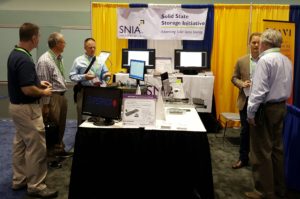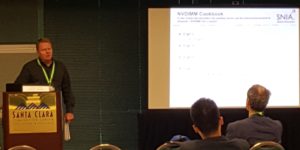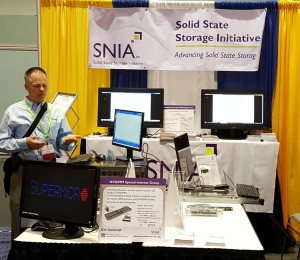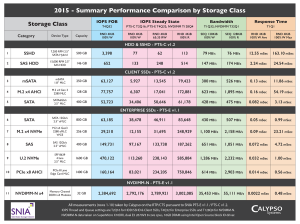by Marty Foltyn
The discussion, use, and application of Non-volatile Memory (NVM) has come a long way from the first SNIA NVM Summit in 2013. The significant improvements in persistent memory, with enormous capacity, memory-like speed and non-volatility, will make the long-awaited promise of the convergence storage and memory a reality. In this 4th annual NVM Summit, we will see how Storage and Memory have now converged, and learn that we are now faced with developing the needed ecosystem. Register and join colleagues on Wednesday, January 20, 2016 in San Jose, CA to learn more, or follow http://www.snia.org/nvmsummit to review presentations post- event.
The Summit day begins with Rick Coulson, Senior Fellow, Intel, discussing the most recent developments in persistent memory with a presentation on All the Ways 3D XPoint Impacts Systems Architecture.
Ethan Miller, Professor of Computer Science at UC Santa Cruz, will discuss Rethinking Benchmarks for Non-Volatile Memory Storage Systems. He will describe the challenges for benchmarks posed by the transition to NVM, and propose potential solutions to these challenges.
Ken Gibson, NVM SW Architecture, Intel will present Memory is the New Storage: How Next Generation NVM DIMMs will Enable New Solutions That Use Memory as the High-Performance Storage Tier . This talk reviews some of the decades-old assumptions that change for suppliers of storage and data services as solutions move to memory as the new storage
Jim Handy, General Director, Objective Analysis, and Tom Coughlin, President, Coughlin Associates will discuss Future Memories and Today’s Opportunities, exploring the role of NVM in today’s and future applications. They will give some market analysis and projections for the various NVM technologies in use today.
Matt Bryson, SVP-Research, ABR, will lead a panel on NVM Futures-Emerging Embedded Memory Technologies, exploring the current status and future opportunities for NVM technologies and in particular both embedded and standalone MRAM technologies and associated applications.
Edward Sharp, Chief, Strategy and Technology, PMC-Sierra, will present Changes Coming to Architecture with NVM. Although the IT industry has made tremendous progress innovating up and down the computing stack to enable, and take advantage of, non-volatile memory, is it sufficient, and where are the weakest links to fully unlock the potential of NVM.
Don Jeanette, VP and John Chen, VP of Trendfocus will review the Solid State Storage Market, discuss what is happening in various segments, and why, as it relates to PCIe.
Dejan Vucinc, HGST San Jose Research Center will discuss Latency in Context: Finding Room for NVMs in the Existing Software Ecosystem. HGST Research has been working diligently to find out where is there room in the existing hardware/software ecosystem for emerging NVM technology when viewed as block storage rather than main memory. Vucinc will show an update on previously published results using prototype PCI Express-attached PCM SSDs and our custom device protocol, DC Express, as well as measurements of its latency and performance through a proper device driver using several different kinds of Linux kernel block layer architecture.
Arthur Sainio, Director Marketing, SMART Modular and Co-Chair, SNIA NVDIMM SIG, will lead a panel on NVDIMM. discussing how new media types are joining NAND Flash, and enhanced controllers and networking are being developed to unlock the latency and throughput advantages of NVDIMM.
Neal Christiansen, Principal Development Lead, Microsoft, Microsoft will discuss Storage Class Memory Support in the Windows OS. Storage Class Memories (SCM) have been the topic of R&D for the last few years and with the promise of near term product delivery, the question is how will Windows be enabled for such SCM products and how can applications take advantage of these capabilities.
Jeff Moyer, Principal Software Engineer, Red Hat will give an overview of the current state of Persistent Memory Support in the Linux Kernel.
Cristian Diaconu, Principal Software Engineer, Microsoft will present Microsoft SQL Hekaton – Towards Large Scale Use of PM for In-memory Databases, using the example of Hekaton (Sql Server in-memory database engine) to break down the opportunity areas for non-volatile memory in the database space.
Tom Talpey, Architect File Server Team, Microsoft, will discuss Microsoft Going Remote at Low Latency: A Future Networked NVM Ecosystem. As new ultra-low latency storage such as Persistent Memory and NVM is deployed, it becomes necessary to provide remote access – for replication, availability and resiliency to errors.
Kevin Deierling, VP Marketing, Mellanox will discuss the role of the network in developing Persistent Memory over Fabrics, and what are the key goals and key fabric features requirements.
 (Petabytes) with in-memory/real-time requirements. You’ll understand the interactions with Hadoop/Spark, Tachyon, SAP HANA, NoSQL, and the related infrastructure of DRAM, NAND, 3DXpoint, NV-DIMMs, and high-speed networking and learn what happens to infrastructure design and operations when “tiered-memory” replaces “tiered storage”.
(Petabytes) with in-memory/real-time requirements. You’ll understand the interactions with Hadoop/Spark, Tachyon, SAP HANA, NoSQL, and the related infrastructure of DRAM, NAND, 3DXpoint, NV-DIMMs, and high-speed networking and learn what happens to infrastructure design and operations when “tiered-memory” replaces “tiered storage”.


 SNIA membership, you are invited to attend a very special keynote presented on January 19 at 8:45 am on IT Trends that Matter in 2016, presented by Mr. Hubert Yoshida, CTO of Hitachi Data Systems. Mr. Yoshida will comment on how innovative technology companies that quickly capitalize on business opportunities and satisfy the demands of today’s empowered consumer have caused a wave of disruption. In 2016, businesses will turn to IT for solutions that will keep them competitive. Chief Information Officers will invest in faster delivery of applications and analytics, and transform IT by leveraging the third platform, social, mobile, analytics, and cloud. Mr. Yoshida will advise on how to avoid distractions and remain focused on the IT trends that matter in 2016.
SNIA membership, you are invited to attend a very special keynote presented on January 19 at 8:45 am on IT Trends that Matter in 2016, presented by Mr. Hubert Yoshida, CTO of Hitachi Data Systems. Mr. Yoshida will comment on how innovative technology companies that quickly capitalize on business opportunities and satisfy the demands of today’s empowered consumer have caused a wave of disruption. In 2016, businesses will turn to IT for solutions that will keep them competitive. Chief Information Officers will invest in faster delivery of applications and analytics, and transform IT by leveraging the third platform, social, mobile, analytics, and cloud. Mr. Yoshida will advise on how to avoid distractions and remain focused on the IT trends that matter in 2016.

